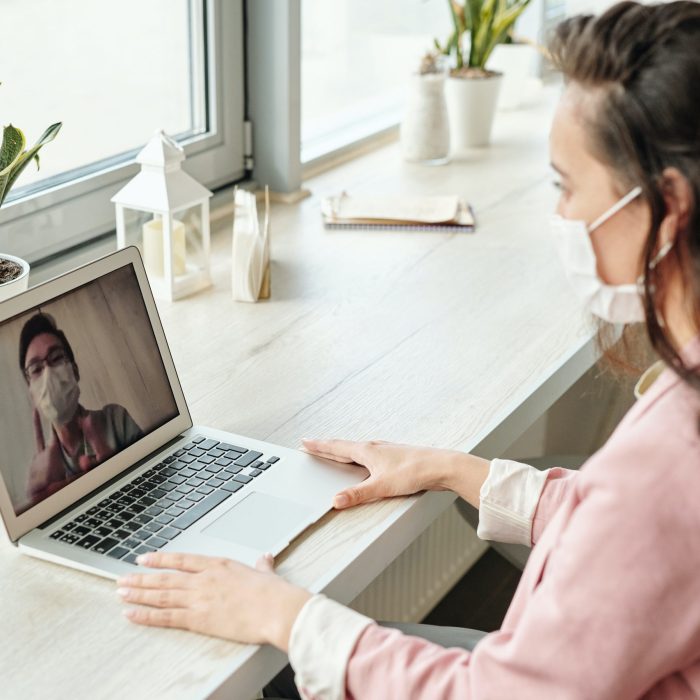Telemedicine has grown more popular over the past few months as physicians utilized new methods to connect with and diagnose their patients in the wake of the COVID-19 shutdowns. However, even before these changes became necessary, many employers and medical offices found that virtual appointments delivered another alternative to providing care for some patients.
Physicians, nurses and other medical personnel can triage patients and the care they require, provide follow-up treatment as needed, and identify complications requiring further attention. For injured workers, this type of support can expedite their recovery and the ability to resume their responsibilities.
“When an injured employee suffers a serious or complex injury, nurses can be a valuable resource to promote recovery and return to work,” says Jennifer Cogbill, vice president, GBCARE at Gallagher Bassett. “What has changed during the COVID-19 pandemic is how nurses engage with the employee. With the disruption in traditional medical care, we’ve seen surgeries postponed or canceled. Physician visits and physical therapy have either been postponed or moved to virtual visits. This can significantly impact recovery and delay return to work. In addition to attending virtual or telephonic visits with providers, nurses also provided critical support by offering alternative strategies for recovery and ensuring the worker is physically ready for surgery when we return to normal.”
At your service
There are a wide range of medical services that can be provided remotely from kiosks in airports and pharmacies that allow individuals to check their pulse, blood pressure, temperature and other vitals to triaging care through telehealth visits. In these cases, nurses usually serve as the gatekeepers who determine what level of care is required for a patient, from a bandage to something more serious.
Dave Lupinsky, vice president of medical review services at CorVel Corporation, which provides health care management services for employers, third-party administrators, insurers and government entities, finds that care management starts by assessing which level of care is required: self-care that patients can provide to themselves with guidance from a nurse or other service provider, telecare provided remotely or care in a traditional brick and mortar location such as an emergency room or occupational clinic for more serious situations.
Within the CorVel system, Lupinsky says their caregivers have the same tools as traditional doctors’ offices. “We wanted them to have access to the same services such as ordering physical therapy (PT).” Even virtual physical therapy is an option now. While physical therapists provide excellent hands-on care to patients, there are benefits to virtual PT. “Patients don’t have to travel, physical therapists have a high level of expertise and they are not bound by geography,” details Lupinsky. Active modalities may include exercises or stretching for patients.
Lupinsky stresses that it’s important to have candid conversations with patients about what they can realistically expect from their care. “We want them to take more control of the situation and get them moving again outside of the medication or procedures they’ve had.”
For most patients, the visits are conducted either over a desktop computer or some sort of mobile device (e.g., cell phone or tablet). “There is less chance of contracting a communicable disease, shorter wait times, the visits are more efficient and there is a better opportunity for real-time monitoring of patients with chronic illnesses because they can communicate regularly with their doctor’s office,” explains Kari Williamson, the CEO of MKC Medical Management, Inc. “Additionally, injured parties in remote locations could benefit from some level of medical assessment…and patients could conceivably have access to specialists, no matter how remote.”
Telehealth visits can also save travel time, parking and other expenses for workers while limiting the amount of time they need to take away from their jobs, cites Lori Ilgenfritz, account principal with Gallagher Bassett’s transportation practice. For workers who travel a lot such as sales professionals or truckers, telemedicine allows them to access treatment regardless of their location.
“Telemedicine is a convenient alternative to traditional office visits for minor injuries, after-hours and re-checks when traditional care is disrupted, whether for COVID-19 or a natural disaster,” finds Bob Evans, director of GBCARE Networks for Gallagher Bassett. “It gives the injured worker the ability to engage with a medical provider while on the road with minimal disruption. All that is needed is an internet connection.”
In addition to flexible scheduling for appointments and the overall convenience, Lupinsky says it is possible to use a small, niche group of physicians for telemedicine. “You can select the best doctors in a wide geographical area to provide care.” He also added that some practices provide Spanish-speaking sites and nurses who speak multiple languages, allowing workers to converse in their native tongue to ensure a clear understanding of the symptoms and care required. Physicians must also be licensed in the state where the patient is located to provide care.
For injured workers, early assessments and triaging the care required can be very helpful, acknowledges Williamson. “The early assessments allow for the employer to assist with management and initiate internal protocols. It also sets a positive rapport between employer and employee, who are working together toward recovery.”
Despite the convenience tele-visits provide, some very real limitations must be considered. Some patients may not be technology savvy and have trouble accessing the patient portal or getting their computer to operate correctly (i.e., turning on the camera or microphone). “Low-grade equipment or a poor internet connection may cause miscommunication between parties,” acknowledges Evans. “Telemedicine also is not applicable for all injury and treatment types due to the limitations with the exam and other services needed.”
Speaking through a computer can also make it more difficult to develop a rapport or have any sort of meaningful engagement with a patient.
“Telemedicine will never completely take the place of hands-on visits and care,” stresses Williamson. “It may not be appropriate for pediatric patients, especially for babies. Children and teens may not give their full attention to the provider. Also, psychological/psychiatric care will have different challenges, especially during acute episodes. Reading or assessing body language, ambulation, range of motion, tone of voice could all be negatively impacted.”
One factor that could be affected by telemedicine involves prescribing medications. How does the physician assess the proper dose and is there a danger of under- or over-prescribing? Prescription renewals would be easier because there are less likely to be adverse effects from existing medication.
False telemedicine claims
Another issue to consider is telemedicine fraud. Protecting patient information and confidentiality is a major issue, particularly since home networks tend to be more vulnerable because computer users do not practice the same level of cybersecurity they do in their offices. Physicians offering telemedicine also have to make sure they use a platform that complies with HIPPA regulations on security, and they must observe state laws about recording calls and conversations.
As telemedicine moves from a niche service to more mainstream use, the value in terms of insurance and workers’ compensation claims will grow exponentially. James Quiggle, senior director of communications for the Coalition Against Insurance Fraud, anticipates that a new surge of tele-scams could well become America’s next large surge of medical fraud.
“Workers’ comp, auto and health insurers could find themselves confronting surges of false telemedicine claims. Insurers in each line have a unique vulnerability due to the large volume of medical claims,” he asserts. “Scams focus on exams, tests and treatments that don’t require physical contact — often abusing telemed codes. Many scams will be familiar, only using telemed as the fraud delivery vehicle. Providers might do dozens of perfunctory, two-minute, tele-consults to see if a patient is injured and needs physical therapy. Doctors bill insurers for one-hour sessions and receive kickbacks for referring patients to the physical therapist.”
Quiggle is concerned that insurers not familiar with telemedicine may not recognize the red flags or billing codes that could be indicative of tele-scams, let alone actually investigate them. “Insurers must know the telemedicine codes well,” he urges. “They’re the gateway to bogus tele-billings.”
“Large crime rings will profit mightily from telemedicine. Telemarketing firms can hire phone boiler rooms to tele-recruit hundreds of bogus patients. The patients are referred to colluding providers for bogus tele-consults and treatment,” he says, outlining how the fraud process will develop. “Even tele-pharmacies might take bogus prescriptions for expensive and unneeded compound meds or painkillers. Everyone feasts off of kickbacks and inflated claims. It’s a familiar crime, although it abuses telemedicine instead of traditional brick-and-mortar medicine.” Soft tissue injuries such as whiplash could also be easy prey for telemedicine scammers.
Quiggle sees telemedicine redefining health care as we know it today. “Patients will prefer the convenience of receiving much of their health care in their living room instead of spending half a day going to the doctor’s office. A generation of digital natives — 80 million millennials — will want telemed. Insurers will have to offer robust telemed as a competitive benefit to attract patients.”
However there will be a significant downside to the explosive growth of telemedicine, predicts Quiggle. “Dishonest medical providers and crime rings will follow the telemed money trail. They’ll launch tele-scams that become America’s next large surge of medical fraud.”
Additionally, Quiggle believes that large medical rings will likely try to exploit the workers’ comp system. In many cases, rings are already defrauding insurers with what he describes as ‘industrial-level’ claims for unneeded, inflated or phantom treatments. “Telemedicine will be another opening to try to defraud workers’ comp insurers.”
Preventing claims abuse
Insurers can take practical steps to prevent telemedicine fraud. Knowing the actual codes will be critical in identifying false claims. It is also vital that they be aware of the rules, regulations and laws for each state. The state medical boards approve these regulations and there will be differences to consider. “Know the limits of reimbursable telemedicine in each jurisdiction and how it has expanded,” advises Quiggle. “Adjust your analytics to spot anomalies in telemed billings and develop models of telemedicine claims that you’ll reimburse and contest. Determine your acceptable claim types, cost, frequency and severity.”
He also recommends conducting a detailed threat analysis to learn about tele-fraud exposures and suggests trying to slip fake claims through the system to see if they can be identified and where there are gaps. Staff training will also be crucial for identifying potential fraud schemes. This includes special investigative units, claims adjusters, managers and others.
The convenience of telemedicine, the positive impact it can have on employees’ care and expediting their return to work, plus its cost-effectiveness are just several reasons why it is here to stay. Williamson says it is also possible it could be expanded for interdisciplinary conferencing, particularly for complex injuries and illnesses.
While not a panacea, telemedicine does provide another tool for medical professionals to connect with patients, particularly in a time when social distancing seems prudent. However, like every aspect of new technology, it needs to be implemented wisely.








